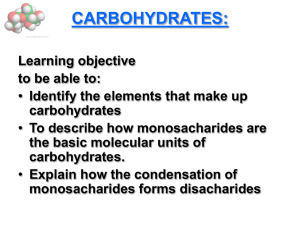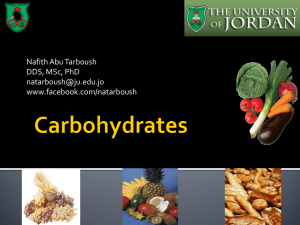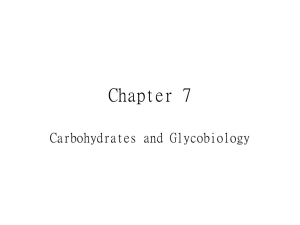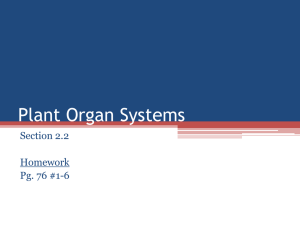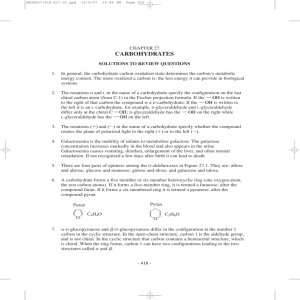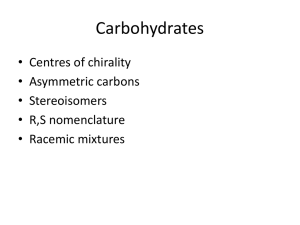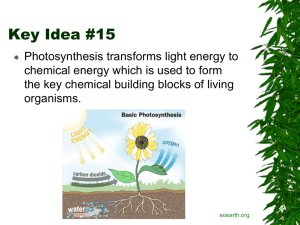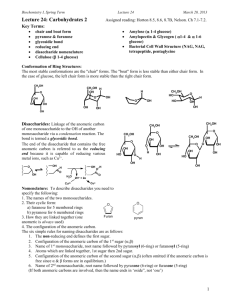Carbohydrates
advertisement
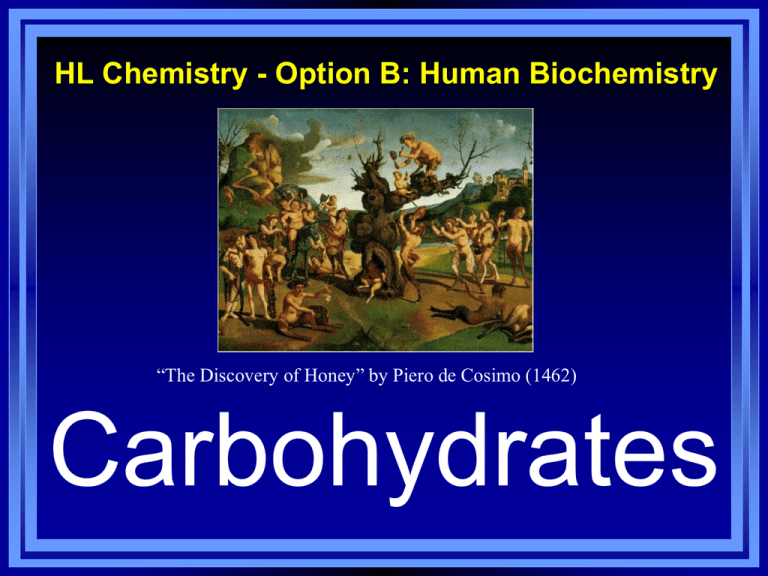
HL Chemistry - Option B: Human Biochemistry “The Discovery of Honey” by Piero de Cosimo (1462) Carbohydrates Part 1 Overview of Carbohydrates General Characteristics • • • • • The term carbohydrate is derived from the French: “hydrate de carbone” All carbohydrates are compounds composed of (at least) C, H, and O The general formula for a carbohydrate is: (CH2O)n (e.g. when n = 5 then the formula would be C5H10O5) Not all carbohydrates have this empirical formula (e.g. deoxysugars, aminosugars, etc.) Carbohydrates are the most abundant compounds found in nature (e.g. cellulose: 100 billion tons annually) General Characteristics • In nature, most carbohydrates are found bound to other compounds rather than as simple sugars • Polysaccharides (starch, cellulose, inulin, gums) • Glycoproteins and proteoglycans (hormones, blood group substances, antibodies) • Glycolipids (cerebrosides, gangliosides) • Glycosides • Mucopolysaccharides (hyaluronic acid) • Nucleic acid polymers Carbohydrate Functions Carbohydrates can be: • Sources of energy • Intermediates in the biosynthesis of other basic biochemical entities (fats and proteins) • Associated with other entities such as glycosides, vitamins and antibiotics) • Structural tissues in plants and in microorganisms (cellulose, lignin, murein) • Involved in biological transport, cell-cell recognition, activation of growth factors, modulation of the immune system Classification of Carbohydrates Carbohydrates can be classified by size: • Monosaccharides (monoses or glycoses) • Trioses, tetroses, pentoses, hexoses • Oligosaccharides • Di, tri, tetra, penta …up to 10 • (The disaccharides are the most important) • Polysaccharides (or glycans) • Homopolysaccharides (all the same type) • Heteropolysaccharides (mixtures of momomer types) • Complex carbohydrates (joined to noncarbohydrate molecules) Monosaccharides • • • • • Monosaccharides are also known as “simple sugars” They are classified by (1) the number of carbons and (2) whether they are aldoses or ketoses (more to come on this!) Most (99%) simple sugars are straight chain compounds D-glyceraldehyde is the simplest of the aldoses (aldotriose) All other sugars have the ending ose (glucose, galactose, ribose, lactose, etc…) Monosaccharides Aldoses (e.g. glucose) have an aldo (aldehyde) group at one end H Ketoses (e.g. fructose) have a keto (ketone) group (usually at C2) O CH2OH C C O HO C H OH H C OH OH H C OH H C OH HO C H H C H C CH2OH CH2OH D-glucose D-fructose Aldose sugars H (H C O C O H)n C H2O H Aldose H H H H C O C OH C H2O H Aldotriose n =1 C O H C OH H C OH C H2O H Aldote trose n =2 H C O H C OH H C H C C O H C OH OH H C OH OH H C OH H C OH C H2O H Aldope ntose n =3 C H2O H Aldohe xose n =4 Ketose sugars C H2O H (H C O C O H)n C H2O H C O C H2O H C H2O H Ke tose H C O C OH C H2O H Ke totriose n =0 C H2O H C H2O H Ke tote trose n =1 C O C H2O H H C OH C O H C OH C OH C H2O H Ke tope n tose n =2 H H H OH C OH C H2O H Ke toh e xose n =3 D- vs L- Designation D & L designations are based on the configuration about the single asymmetric C in glyceraldehyde The lower diagrams are Fischer Projections. CHO CHO H C OH HO L-glyceraldehyde CHO H C OH CH2OH D-glyceraldehyde H CH2OH CH2OH D-glyceraldehyde C CHO HO C H CH2OH L-glyceraldehyde Sugar Nomenclature For sugars with more than one chiral center, D or L refers to the asymmetric C farthest from the aldehyde or keto group (in yellow) Most naturally occurring sugars are D isomers O H C H – C – OH HO – C – H H – C – OH H – C – OH CH2OH D-glucose O H C HO – C – H H – C – OH HO – C – H HO – C – H CH2OH L-glucose O H O H D & L sugars are mirror images of one another C C They have the same root H – C – OH HO – C – H name (but a different HO – C – H H – C – OH D/L designation), H – C – OH HO – C – H [e.g. D-glucose & L-glucose] H – C – OH HO – C – H Other stereoisomers CH2OH CH2OH have unique names, D-glucose L-glucose (e.g. glucose, mannose, galactose, etc) The number of stereoisomers is 2n, where n is the number of asymmetric (chiral) centers The 6-C aldoses have 4 asymmetric centers. Thus there are 16 stereoisomers (8 D-sugars and 8 Lsugars). Structure of a Simple Aldose and a Simple Ketose Enantiomers and Epimers H H H H C O H C OH H C OH C O C O C O HO C H HO C H OH C H HO C H HO C H OH C H H C OH HO C H H th e se two aldote trose s are e n an tiom e rs. Th e y are ste re oisom e rs th at are m irror im age s of e ach oth e r C OH H C OH C H2O H C H2O H C H2O H C H2O H th e se two aldoh e xose s are C -4 e pim e rs. th e y diffe r on ly in th e position of th e h ydroxyl grou p on on e asym m e tric carbo (carbon 4) Relationship Between D- & L-Fructose Properties of Optical Isomers • The differences in structures (configurations) of sugar optical isomers are responsible for variations in properties • Physical Differences Between D- & L- forms • Crystalline structure; solubility; rotatory power • Chemical Differences Between D- & L- forms • Reactions (oxidations, reductions, condensations) • Physiological Differences Between D- & L- forms • Nutritive value (human, bacterial); sweetness; absorption Structural Representation of Sugars Biomolecules (in this case sugars) can be represented in three main ways (visualized in the following slides): • Fischer Projection: straight chain representation • Haworth Projection: simple ring in perspective • Conformational Representation: chair and boat configurations Pentoses and hexoses can cyclize as the ketone or aldehyde reacts with a distal OH. The top diagram is a Fischer Projection of D-Glucose 1 H HO H H 2 3 4 5 6 Glucose forms an intramolecular hemiacetal, as the C1 aldehyde & C5 OH react, to form a 6-member pyranose ring, named after pyran CHO C OH C H C OH (linear form) C OH D-glucose CH2OH 6 CH2OH 6 CH2OH 5 H 4 OH H OH 3 H O H H 1 2 OH -D-glucose OH 5 H 4 OH H OH 3 H O OH H 1 2 OH -D-glucose The representations of the cyclic sugars (bottom) are called Haworth Projections H More Pyran Cyclization CH2OH 1 HO H H 2C O C H C OH C OH 3 4 5 6 HOH2C 6 CH2OH D-fructose (linear) H 5 H 1 CH2OH O 4 OH HO 2 3 OH H -D-fructofuranose Fructose forms either a: 6-member pyranose ring: reaction of the C2 keto group with the OH on C6, or 5-member furanose ring: reaction of the C2 keto group with the OH on C5 6 CH2OH 6 CH2OH 5 H 4 OH H OH 3 H O H H 1 2 OH -D-glucose OH 5 H 4 OH H OH 3 H O OH H 1 2 H OH -D-glucose Cyclization of glucose produces a new asymmetric center at C1. The 2 stereoisomers are called anomers, & Haworth projections represent the cyclic sugars as having essentially planar rings, with the OH at the anomeric C1: (OH below the ring) (OH above the ring) H OH 4 H OH 6 H O HO HO H O HO H HO 5 3 H H 2 H OH 1 OH -D-glucopyranose H OH OH H -D-glucopyranose Because of the tetrahedral nature of carbon bonds, pyranose sugars actually assume a "chair" or "boat" configuration, depending on the sugar The representation above reflects the chair configuration of the glucopyranose ring more accurately than the Haworth projection Chair (top) and Boat (bottom) forms of the Pyranose Ring Optical Isomerism and Polarimetry • • Recall that optical isomerism is a property exhibited by any compound whose mirror images are nonsuperimposable Also, compounds with asymmetric carbons rotate plane polarized light – – Measurement of optical activity in chiral or asymmetric molecules uses plane polarized light – Molecules may be chiral because of certain atoms or because of chiral axes or chiral planes – Measurement uses an instrument called a polarimeter (Lippich type) – Rotation is either (+) dextrorotatory or (-) levorotatory Polarimeter Polarimetry • Magnitude of rotation depends upon: 1. The nature of the compound 2. The length of the tube (cell or sample container) usually expressed in decimeters (dm) 3. The wavelength of the light source employed; usually either sodium D line at 589.3 nm or mercury vapor lamp at 546.1 nm 4. Temperature of sample 5. Concentration of carbohydrate in grams per 100 ml Selected Rotations D-glucose +52.7 D-fructose -92.4 D-galactose +80.2 L-arabinose +104.5 D-mannose +14.2 D-arabinose -105.0 D-xylose +18.8 Lactose +55.4 Sucrose +66.5 Maltose+ +130.4 Invert sugar -19.8 Dextrin +195 Part 2 Oligosaccharides and selected derivatives Oligosaccharides • The most common oligosaccarides are the disaccharides • Sucrose, lactose, and maltose • Maltose hydrolyzes to 2 molecules of Dglucose • Lactose hydrolyzes to a molecule of glucose and a molecule of galactose • Sucrose hydrolyzes to a molecule of glucose and a molecule of fructose Glycosidic Bonds The anomeric hydroxyl and a hydroxyl of another sugar or some other compound can join together, splitting out water to form a glycosidic bond: R-OH + HO-R' R-O-R' + H2O e.g. methanol reacts with the anomeric OH on glucose to form methyl glucoside (methylglucopyranose). H OH H OH H2O H O HO HO H H H + CH3-OH H O HO HO H OH H OH -D-glucopyranose methanol H OH OCH3 methyl--D-glucopyranose Disaccharides: Maltose, a cleavage product of starch (i.e. amylose), is a disaccharide with an (1 4) glycosidic link between the C1 C4 OH’s of 2 glucoses. It is the anomer (C1 O points down) 6 CH2OH 6 CH2OH H 5 O H OH 4 OH 3 H H H 1 H 4 4 maltose OH H H 1 OH 2 H OH 2OH H H 1 O 4 5 O H OH H H 3 H 6 CH O H OH H OH 3 OH 5 O O 2 6 CH2OH H 5 2 OH 3 cellobiose H 2 OH 1 H OH Cellobiose, a product of cellulose breakdown, is the otherwise equivalent anomer (O on C1 points up). The (1 4) glycosidic linkage is represented as a zig-zag, but one glucose is actually flipped over relative to the other Other disaccharides include: Sucrose, common table sugar, has a glycosidic bond linking the anomeric hydroxyls of glucose & fructose. Because the configuration at the anomeric C of glucose is (O points down from ring), the linkage is (12) The full name of sucrose is -D-glucopyranosyl(12)--D-fructopyranose.) Lactose, milk sugar, is composed of galactose & glucose, with (14) linkage from the anomeric OH of galactose. Its full name is -Dgalactopyranosyl-(1 4)--D-glucopyranose Sucrose • • • • • Probably the most famous sugar, and everyone’s favorite, is sucrose: -D-glucopyranosido--D-fructofuranoside -D-fructofuranosido--D-glucopyranoside Also known as table sugar Commercially obtained from sugar cane or sugar beet Hydrolysis yield glucose and fructose (invert sugar) ( sucrose: +66.5o ; glucose +52.5o; fructose –92o) Used pharmaceutically to make syrups Lactose • • • Lactose is another famous disaccharide, resulting from -D-galactose joining to -D-glucose via a -(1,4) linkage Milk contains the a and b-anomers in a 2:3 ratio -lactose is sweeter and more soluble than ordinary - lactose Used in infant formulations, medium for penicillin production and as a diluent in pharmaceuticals Starch • • • Starch is the most common storage polysaccharide in plants It is composed of 10 – 30% amylose and 70-90% amylopectin (depending on the source) The chains are of varying length, having molecular weights from several thousands to half a million Polysaccharides CH 2OH H O H OH H H H 1 O OH 6CH OH 2 5 O H 4 OH 3 H OH H H H H 1 O H OH CH 2OH CH 2OH CH 2OH H H H O H OH H O O H H O H OH H H O OH 2 OH H OH H OH H OH amylose Plants store glucose as amylose or amylopectin. Glucose polymers collectively are called starch. Glucose storage in polymeric form minimizes osmotic effects. • Amylose is a glucose polymer with (14) linkages. It adopts a helical conformation (see above) • The end of the polysaccharide with an anomeric C1 not involved in a glycosidic bond is called the reducing end • CH 2OH CH 2OH O H H OH H H OH H O OH CH 2OH H H OH H H OH H H OH CH 2OH O H OH O H OH H H O O H OH H H OH H H O 4 amylopectin H 1 O 6 CH 2 5 H OH 3 H CH 2OH O H 2 OH H H 1 O CH 2OH O H 4 OH H H H H O OH O H OH H H OH H OH Amylopectin is a glucose polymer with mainly (14) linkages, but it also has branches formed by (16) linkages (see above). Branches are generally longer than shown above. • The branches produce a compact structure & provide multiple chain ends at which enzymatic cleavage can occur. • Another view of amylose and amylopectin, the two forms of starch. Amylopectin is a highly branched structure, with branches occurring every 12 to 30 residues Glycogen • • • • • • • Glycogen is also known as “animal starch” (not really an accurate description!) It is stored in muscle and liver tissue Also present in cells as granules (high MW) It contains both -(1,4) links and -(1,6) branches at every 8 to 12 glucose unit Complete hydrolysis yields glucose Glycogen and iodine gives a red-violet color Hydrolyzed by both and -amylases and by glycogen phosphorylase [these are enymes] CH 2OH CH 2OH O H H OH H H OH H O OH CH 2OH H H OH H H OH H H OH CH 2OH O H OH O H OH H H O O H OH H H OH H H O 4 glycogen H 1 O 6 CH 2 5 H OH 3 H CH 2OH O H 2 OH H H 1 O CH 2OH O H 4 OH H H H H O OH O H OH H H OH H OH Glycogen, the glucose storage polymer in animals, is similar in structure to amylopectin, but glycogen has more (16) branches • The highly branched structure permits rapid release of glucose from glycogen stores, i.e. in muscle during exercise. The ability to rapidly mobilize glucose is more essential to animals than to plants • Cellulose • Cellulose is a polymer of -D-glucose attached by -(1,4) linkages • It yields glucose upon complete hydrolysis • Partial hydrolysis yields cellulobiose • Cellulose is the most abundant of all carbohydrates • Cotton flax: 97-99% cellulose • Wood: ~ 50% cellulose • Cellulose gives no color with iodine • Held together with “lignin” in woody plant tissues CH 2OH H O H OH H OH H 1 O H H OH 6CH OH 2 5 O H 4 OH 3 H H H 1 2 OH O O H OH CH 2OH CH 2OH CH 2OH H H O O H OH H OH O H O H OH H OH OH H H H H H H H OH cellulose Cellulose, a major constituent of plant cell walls, consists of long linear chains of glucose with (14) linkages. • Every other glucose is flipped over, due to the linkages. This promotes intra-chain and inter-chain Hbonds and van der Waals interactions. This cause cellulose chains to be straight & rigid, and pack with a crystalline arrangement in thick bundles called microfibrils • Schematic of arrangement of cellulose chains in a microfibril. The Linear Structures of Cellulose and Chitin (chitin is found in the exoskeleton of insects, crayfish, etc] (these are the two most abundant polysaccharides in nature) The Molecular Structure of Cellulose (Notice the presence of “sheets” that can be pealed away. Think about a piece of celery and how you can strip off the fibers) Suspensions of amylose in water adopt a helical conformation Iodine (I2) can insert in the middle of the amylose helix to give a blue color that is characteristic and diagnostic for starch (a) The structure of starch – shows linkages (b) The structure of cellulose – shows linkages Oligosaccharides that are covalently attached to proteins or to membrane lipids may be linear or branched chains C CH2OH O H H OH O CH2 CH NH H O serine residue O H OH H HN C CH3 -D-N-acetylglucosamine O-linked oligosaccharide chains of glycoproteins vary in complexity. • They link to a protein via a glycosidic bond between a sugar residue and a serine or threonine OH • O-linked oligosaccharides have roles in recognition, interaction, and enzyme regulation The Structures of Serine or Threonine O-linked Saccharides O-linked glycoproteins are found in the blood of Arctic and Antarctic fish, enabling them to live at sub-zero water temperatures C CH2OH O H H OH O CH2 CH NH H O serine residue O H OH H HN C CH3 -D-N-acetylglucosamine • N-acetylglucosamine (GlcNAc) is a common O-linked glycosylation product of serine or threonine residues • Many cellular proteins, including enzymes & transcription factors, are regulated by reversible GlcNAc attachment • Often attachment of GlcNAc to a protein OH alternates with phosphorylation, with these 2 modifications having opposite regulatory effects (stimulation or inhibition) CH2OH O O H H OH HN C HN CH2 C H H OH H HN C CH3 O N-acetylglucosamine Initial sugar in N-linked glycoprotein oligosaccharide Asn CH O HN HC R C O X HN HC R C O Ser or Thr N-linked oligosaccharides of glycoproteins tend to be complex and branched. First N-acetylglucosamine is linked to a protein via the side-chain N of an asparagine residue in a particular 3-amino acid sequence. The Structure of Aspargine N-linked Glycoproteins More Examples of N-Linked Glycoproteins Selected Facts About Oligosaccharide Derivatives • Many proteins secreted by cells have attached N-linked oligosaccharide chains • Genetic diseases have been attributed to deficiencies of particular enzymes involved in synthesizing or modifying these glycoprotein oligosaccharide chains • Such genetic diseases, and gene knockout studies in mice, have been used to define pathways of modification of oligosaccharide chains in glycoproteins and glycolipids. • Carbohydrate chains of plasma membrane glycoproteins and glycolipids usually face the outside of the cell • Plasma membrane glycoproteins and glycolipids have roles in cell-cell interaction and signaling, as well as forming a protective layer on the surface of some cells Special Monosaccharides: Deoxy Sugars • • • Some monosaccharides lack one or more hydroxyl groups on the molecule. These are “deoxy sugars” One ubiquitous deoxy sugar is 2’-deoxy ribose which is the sugar found in DNA 6-deoxy-L-mannose (L-rhamnose) is used as a fermentative reagent in bacteriology A Few Examples of Deoxysugar Structures
